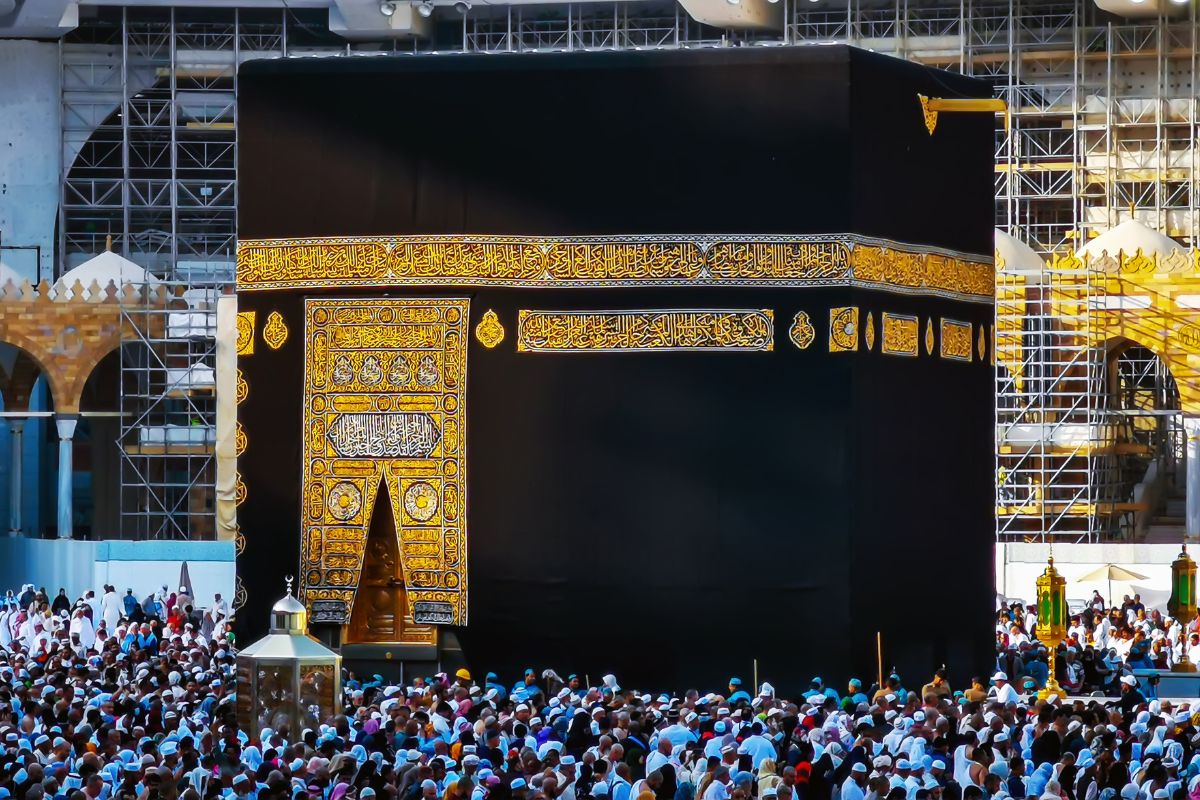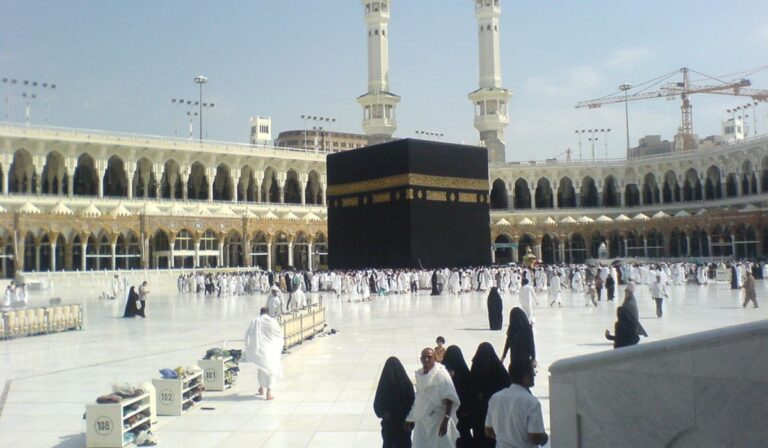Makkah:
Situated in Saudi Arabia, Makkah emerges as a holy refuge, drawing millions of Muslims annually to embark on the sacred journey of Hajj. Hajj, one of the Five Pillars of Islam, stands as a witness to the lasting spiritual significance of this ancient city. In our exploration of Makkah, we will explore its rich history, delve into the spiritual heart of Masjid al-Haram, go across the vibrant shopping centers, and savor the flavors of local cuisine.
Location on Map
1. Makkah’s Timeless History:
Makkah’s roots stretch deep into ancient times, with historical accounts linking with religious narratives. It is that holy city in which Prophet Hazrat Muhammad (صلی الله علیه وسلم) was born, and where the first verses of the Quran were revealed. The city has witnessed the flow of civilizations, its blessed grounds a silent witness to the unfolding of centuries.
2. Holy Kaaba
The Kaaba in Makkah is like the special heart of the city. It’s a simple, black, cube-shaped building that Muslims face when they pray. Long ago, Prophet Ibrahim and his son built it for worshipping one Allah. People from everywhere, rich or poor, stand together in unity around the Kaaba during Hajj and Umrah, showing that everyone is equal in the eyes of Allah. The Kaaba’s simple design reminds us that a true connection with God doesn’t need fancy things. It’s a special place that brings people together, making Makkah not just a city, but a spiritual home for millions around the world.

3. Masjid al-Haram:
Masjid al-Haram, the Grand Mosque, surrounding the respected Kaaba, it stands as a symbol of unity, humility, and firm devotion. The call to prayer resonates through its blessed halls, summoning the faithful to engage in acts of worship that connect them with ALLAH ALMIGHTY. Hajj, the pilgrimage that takes place annually, is a pillar of Islam and an insightful journey that attracts believers from every corner of the globe.

4. Hajj-Pillar of Islam:
Hajj is a pilgrimage, a spiritual journey that repeats the footsteps of Prophet Ibrahim (Abraham) and his family. Pilgrims, dressed in simple white garments, walk around the Kaaba in Tawaf, symbolizing the unity of the Muslim Ummah. The services done during Hajj are a powerful expression of submission to Allah, adopting a sense of equality among the pilgrims as they stand shoulder to shoulder in prayer.
5. Abraj Al-Bait Towers
Makkah’s skyline is dominated by the striking Abraj Al-Bait Towers, a modern architectural marvel that houses luxury hotels, shopping centers, and residential apartments. The towers are not just a symbol of modern development but also a signal to Makkah’s role as a global Islamic center. From the top floors, visitors are treated to panoramic views of the Masjid al-Haram, creating a unique collocation of tradition and modernity.

6. Historic Landmarks:
Makkah is adorned with historic landmarks that echo tales of centuries gone by. The Zamzam Well, a source of blessed water, holds deep historical significance, dating back to the times of Prophet Ibrahim and his family. The hills of Safa and Marwah, crossed by pilgrims during Hajj and Umrah, symbolize spirit and faith, honoring the actions of Amma Hajra, the wife of Prophet Ibrahim.
7. Spiritual Atmosphere:
The spiritual atmosphere of Mecca is not limited to the splendor of Masjid al-Haram only. The entire city echoes with a unique energy, especially during the Hajj season. The air is filled with prayers, Quran recitations, and the collective heartbeat of millions of worshippers. Even outside the holy grounds, the city displays a sense of respect, inviting visitors to pray and to worship ALLAH ALMIGHTY.
8. Inclusive Gathering:
Makkah’s significance extends beyond religious boundaries. While it is the holiest site for Muslims, the city welcomes people of all backgrounds. The inclusivity of Makkah is evident during Hajj, where people from diverse cultures and languages meet, united by a common faith. This gathering symbolizes the universal nature of Islam, raising a sense of global unity and brotherhood. Makkah is must must-visit destination for those who want to explore different cultures and people at a single place.
9. Educational Centers:
Mecca is not only a spiritual hub but also a center for knowledge and education. The city is home to prominent Islamic universities and institutions that attract scholars and students from around the world. These institutions contribute to the distribution of Islamic teachings, making Makkah a focal point for intellectual and academic quests within the Islamic world.
10. Shopping Splendors:
Makkah’s bustling souks (markets) are a sensory delight, offering an array of goods that reflect the city’s rich cultural heritage. From elegant fabrics to superb perfumes and sophisticated handicrafts, the markets provide pilgrims and visitors with an opportunity to immerse themselves in the traditions of Makkah. The sounds of haggling, the scent of oud (a fragrant oil extracted from tree resin), and the vibrant colors create an atmosphere that is both lively and enchanting.
11. Technological Advancements:
Mecca has embraced technological advancements to enhance the experience of pilgrims. From crowd management systems to mobile applications providing real-time prayer schedules and guidance, technology plays a vital role in ensuring a smooth and organized journey. This blend of tradition and innovation showcases Makkah’s commitment to facilitating the spiritual journey for pilgrims in the modern era.
Also Read: 5 Best Hotels in Makkah Near Haram
Frequently Asked Questions:
| 1. What contributes to the Makkah’s respect status in Islam? | Makkah’s significance in Islam is attributed to being the birthplace of Prophet Muhammad and hosting the sacred Kaaba. |
| 2. How is the pilgrimage to Mecca, commonly known as Hajj, performed? | Hajj involves various acts of worship, including Tawaf around Makkah’s Kaaba and symbolic actions commemorating Prophet Ibrahim’s experiences. |
| 3. Which historical landmarks can be explored within Makkah’s sacred grounds? | Makkah’s sacred grounds are adorned with historic landmarks like the Zamzam Well and the hills of Safa and Marwah, each holding profound significance. |
| 4. How does Makkah adopts an inclusive atmosphere during Hajj? | During Hajj, Makkah welcomes individuals from diverse backgrounds, creating an inclusive atmosphere for people of different cultures and languages. |
| 5. In what ways does technology enhance the pilgrimage experience within Makkah’s sacred precincts? | Makkah embraces technological advancements, utilizing crowd management systems and mobile applications to provide real-time information and guidance for pilgrims. |
| 6. How does Mecca strike a balance between historical charm and modern developments? | Makkah takes pride in preserving its historical and architectural heritage, maintaining the charm of the old city with narrow alleys and traditional buildings while incorporating modern developments. |






